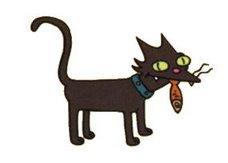Educational Sidebar: Badgers
Badgers are Mustelids (members of the Weasel family) and are related to such smelly and/or angry animals as wolverines, ferrets, otters, fishers, martens, and minks. Yeah sure he looks cute but he'd kill ya soon as look at ya. They are the only carnivore in Canada that burrows after and eats other burrowing animals, so we like them here because they eat things like ground squirrels (and anything else they can get there claws on). The species of badger that occurs in North America is the North American badger (Taxidea taxus) which is somewhat related, but quite different from the European badger (Meles meles). 
Badgers are very distinctive looking, especially their faces (a good way to tell between the Euro and north american badger is by snout length). Badgers have a noticeable white stripe that runs down the top of their head as well as black cheek patches (called “badges” which is how badgers get their name). They are about 60-90 cm (2-3 ft.) in length and generally weigh about 7-8 kg (15.4-17.6 lbs.) for adult females and 10-14 kg (22-30.8 lbs.) for adult males. Badgers have a sort of “flattened” appearance because their hair is short on their backs and long on their sides (also because they have stubby little legs). Their forefeet are actually much larger than their hindfeet (all the better for burrowing with grandma). Badgers are quite highly adapted for digging and can actually dig up to a metre deep in a minute!  Now is that a probe or a test he's digging because I doubt that takes screening into account.
Now is that a probe or a test he's digging because I doubt that takes screening into account.

 This is in contrast to Meles meles (right) which has a much more flattened M1
This is in contrast to Meles meles (right) which has a much more flattened M1(Pop Quiz: which one is more omnivorous?).
It has a relatively short rostrum, and robustjaws at the rostral end of the skull and at the base it has a triangular shaped occipital and enlarged tympanic bullae. The "wrap-around" jaw hinge means that lowerjaw cannot be removed from skull. Male badgers have a prominent sagittal crest which increases in size with age.
Also, badgers are better with the Simpsons:




1 comment:
otters are not angry! i resent that!
also, i've been brainwashed by watching 'wind in the willows' as a child and cannot think of badgers in a non-anthropomorphic way.
k.
Post a Comment